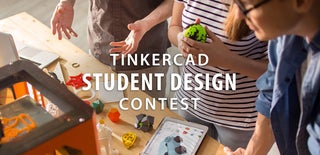Introduction: The Automated Planter
Hello everyone, this automated planter has a full mechanical system that makes all it's parts move consequently to plant effectively a seed in the ground. This project is fully designed on TinkerCad and it is a great tutorial to work on for high education students or higher. The project composite of three parts first the tank body which is considered the base where the two other parts rely on, the second part is the mechanical system related to the planting process that is fixed on the top of the tank (the planting process is done by first drill through the land, then add water and seeds, then cover the drilled soil over the seeds), and finally the third part is the electronic parts that is based on Arduino. All these parts will be explained in this instrutable to be as simple as possible. One goal of this project is to encourage students and innovators to work on such products that support the community to have a better environment and make an effective change in the agricultural field.
Step 1: TinkerCad
Visit via this link: https://www.tinkercad.com/things/j6Awo68DYPJ
Attachments
Step 2: Body of the Tank
The body of the tank is composite of two parts joined together. So, how I designed this body? first you should form a trapezoid then add four small circles with edge of 2mm at the corners of the trapezoid, then join them together by selecting all the parts together using the joining button. after that make sure that both parts are the same on both sides to add them by creating rectangle in between to fix all the parts together. The circular space in the center of the body is for the planter mechanism done by the mechanical part in the center. finally add the hole sphere in the center of the body then join them together.
( I've added the body design above if you want to just insert it to tinkercad as an stl file.)
.
Attachments
Step 3: Tank Track
The tank track of this project is considered as the most vital mechanical element in this automated planter since the motion of the the planter depend on this mechanical track. Mainly this part is composed of the wheels and the track. The 3D design of the the wheel and the track is little bit challenging, but don't worry I downloaded the stl files of them above so you can download them. First to design the wheels you should start by a simple circle, then add another circle in the middle of the first circle but of bigger radius, then after that make using a cylindrical shape to empty the outer circle in a sequence to become as gear. Second, to design the track part is by creating rectangle, then make at the edges a two holes shapes as nonparallel then form on the surface rectangular shapes as holes in tinkercad to form the above shape, the last part is from the bottom where you can join them together and is done by adding two rectangles with holes on the edge from one side then from the other side make the same thing but in a way so that they are not on the same path. Keep in mind that after you print the stl file of the track you should add them together piece by piece, in the 3D design we join the track parts together to form the shape only.
Step 4: The Large Gear
This gear is done using the gear shape in the categories of tinkercad and make them larger, then make circular holes on the four sides of the gear.
Attachments
Step 5: Planter Mechanical Part
The planting process in this automated planter depends on this part. It is composed of five components that are important for every planting process which are water tank, drill, covering tool, soil moisture sensor, and the seeder.The process is done by first drill a hole for the seed, add some water, then release the seeds in the hole, then cover them over the hole. The design of this part is fixed on some electronic parts connected to Arduino. The design is of the different parts is by using the different shapes in the category of tinkercad that I will show you some of them inn the next step.
Attachments
Step 6: Favorite Shapes
As a tip favorite your most used shapes to be easy for you to use them.
Step 7: Electronic Parts
Tinnkercad offers for you also to stimulate electronic parts together, in this this project the electronic parts are motor sensor like soil moisture and temperature and ultra sonic sensors, servo motors, and .the solar panel, and of course the arduino board. The code of this project will be completely explained in other instructable with other electric connections.
Step 8: Here's We Are Done
Hope you enjoy my instructable, and I hope you benefit from the idea of 3D designing of this automated planter.

Participated in the
Tinkercad Student Design Contest













